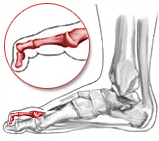MALLET TOE
If you’ve experienced an injury or suffer from pain or deformity in the toes, please don’t hesitate to Schedule an appointment with one of our orthopedic specialists.
 What is Mallet Toe?
What is Mallet Toe?
Mallet Toe refers to a specific type of hammertoe deformity, within the broader category of hammer toe syndrome. Other hammertoe types include hammertoe, clawtoe, overlapping fifth toe, and curly toe.
The Mallet toe experiences a deforming force in one plane where the distal interphalangeal joint (DIPJ) hyper-flexes and the proximal interphalangeal joint (PIPJ) and metatarsophalangeal joint
(MPJ) remain unaffected. Mallet toe may cause foot pain from the rubbing of the skin onto surfaces, which
may further cause irritation, sores, calluses, corns, and open wounds.
Your surgeon can address this issue conservatively in multiple ways including padding, taping, shoe gear changes, injections, and anti-inflammatory medication.
However, if the mallet toe continues to worsen the patient’s symptoms, physicians may address the deformity surgically.
Your surgeon may address a mallet toe by performing a toe arthroplasty, phalangectomy, flexor tendon releases, tendon transfer, and/or toe arthrodesis (IPJ fusion). The purpose of hammertoe or mallet toe surgery includes relieving pain, reducing deforming forces, improving function, and preventing progression of a worsening hammertoe contracture.
Toe Arthroplasty
Toe arthroplasty refers to removing part of the bone in a joint causing a deformity. Patients may require Joint resection to reduce the contracture, which facilitates toe relaxation. Your surgeon
creates a small incision (1-1.5cm) over the toe and releases the joint capsule, extensor tendon, and exposes the joint. Once exposed, the surgeon removes the bone causing the deformity at
an appropriate length. The surgeon then sutures the tendons, joint capsule, and skin back together. The surgical correction of the toe may require pinning using wires to prevent post-operative toe contracture while the skin heals.
Recovering from a Mallet Toe Surgery.
After the surgery, patients will find their foot bandaged and numbed, and go home with a padded shoe and an assistive device if necessary. They will do light exercises at home to strengthen the foot and speed up recovery time. As an outpatient procedure, most patients will go home from the hospital with some painkillers the same day as the operation, after setting up a follow-up appointment.
During the first few weeks, your physician will suggest patients rest their foot, keep it elevated, and take the prescribed pain medication.
Follow-up Appointments
Healing and post-operative strategies tend to vary from person to person. Typically, the postoperative healing schedule follows this pattern:
- At two weeks your physician will remove your bandages, remove stitches, and examine the foot.
- At six weeks the physician will examine the foot again with X-rays to make sure it heals properly.
- At 12 weeks the physician will give one final check before fully discharging you.
How Soon Can I Walk After a Hammertoe/Mallet Toe Surgery?
Your surgeon will advise you about the type of footwear you should use and how quickly you will recover.
Weeks 0-2 will require light activity and partial heel weight-bearing with a prescribed short protective walking boot or hospital shoe.
Weeks 3-6 will gradually return to normal activity after the doctor has completely removed the bandages, stitches, and wires.
After six weeks – you can walk in comfortable-fitting shoes.

 What is Mallet Toe?
What is Mallet Toe?